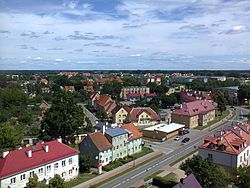Pisz
| Pisz | ||
|---|---|---|

Panorama of the town
|
||
|
||
| Coordinates: 53°37′N 21°48′E / 53.617°N 21.800°E | ||
| Country |
|
|
| Voivodeship | Warmian-Masurian | |
| County | Pisz County | |
| Gmina | Gmina Pisz | |
| Established | 14th century | |
| Town rights | 1451-1455, 1645 | |
| Government | ||
| • Mayor | Jan Alicki | |
| Area | ||
| • Total | 10.04 km2 (3.88 sq mi) | |
| Population (2006) | ||
| • Total | 19,332 | |
| • Density | 1,900/km2 (5,000/sq mi) | |
| Time zone | CET (UTC+1) | |
| • Summer (DST) | CEST (UTC+2) | |
| Postal code | 12-200 | |
| Area code(s) | +48 87 | |
| Car plates | NPI | |
| Website | http://www.pisz.pl/ | |
Pisz [pʲiʂ] (previously also Jańsbork, German: Johannisburg) is a town in the Warmian-Masurian Voivodeship in Poland, with a population of 19,328 in 2004. It is the seat of Pisz County. Pisz is located at the junction of Lake Roś and the Pisa River.
The name Pisz originates from the word "pisa", meaning "swamp" in the ancient Prussian language. Pisz received the name of the castle in 1645, when it became a city by the decree of Władysław IV Vasa. The local people of Mazury called the castle "Jańsbork", and this name remained until 1946.
The site of today's Pisz was originally inhabited by the indigenous ethnic group of Old Prussians. In 1345 the Teutonic Order began constructing a castle nearby at the southernmost point of the Johannisburger Heide, or Piska Forest, in the Masurian Lake District. The castle was named Johannisburg, after St. John the Baptist. The settlement nearby held a market as early as 1367, but it was not until 1645 that it received its town charter. The town's first mayor was Fryderyk Adam Czerniewski. The official German name of the town was Johannisburg, while the Polish-speaking residents referred to it as Jańsbork. Its early growth owed much to the residents' skill in beekeeping, and it was located on trade routes leading to Gdańsk and to the Vistula and Narew Rivers. It became part of Ducal Prussia in 1525 and Brandenburg-Prussia in 1618.
...
Wikipedia


